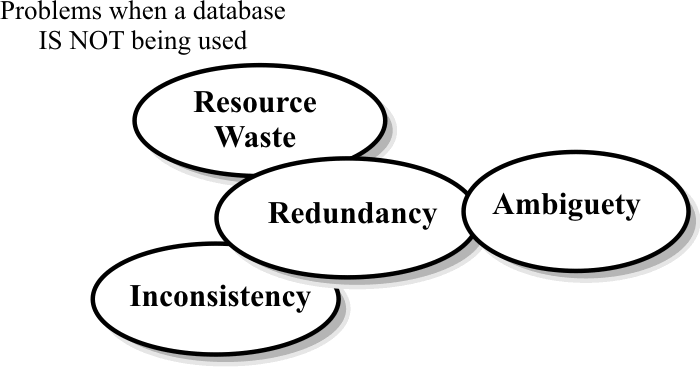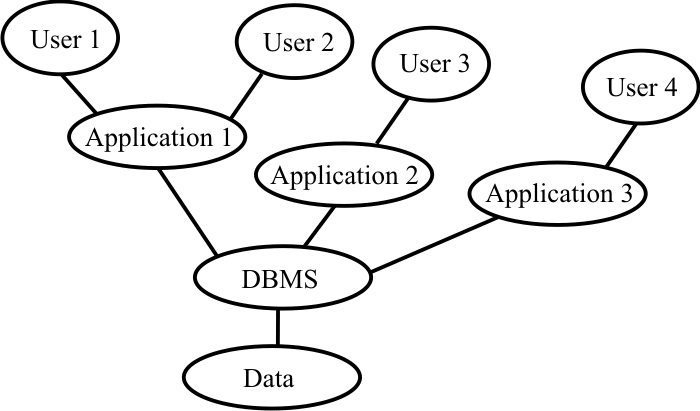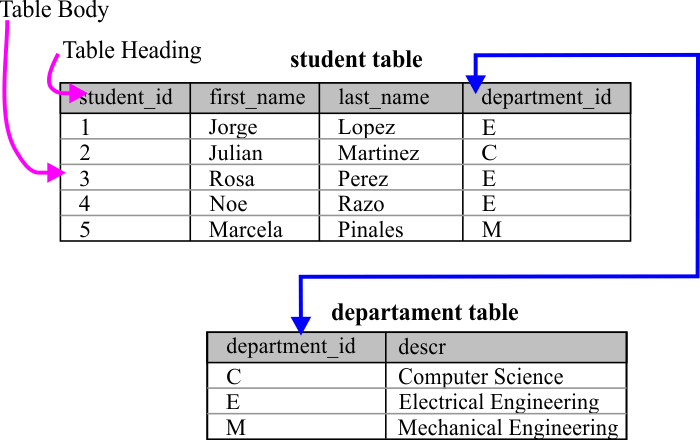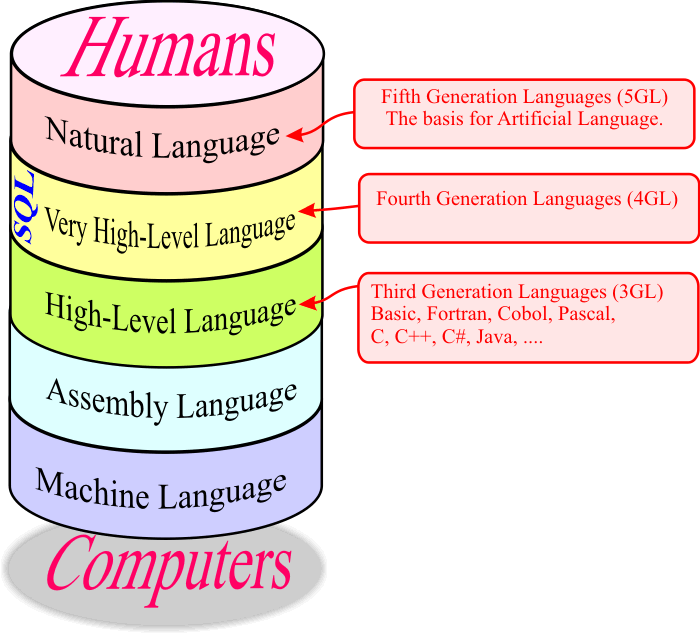Database System |
| It is any computer-based information system where the data that supports that system can be used by a wide variety of applications and is not arranged in such a way that it can only support one particular application. Es un sistema de información basado en computadoras donde los datos se almacenan de tal forma que pueden ser usados en cualquier tipo de aplicación, esto es, la organización de los datos no impone ninguna restricción para almacenar o retraer los datos. |

| Tip |
| Database systems provide many benefits: integrated files, no redundancy, easy in updating, quick and efficient, enables users to share data, centralized security. Los sistemas de bases datos proporcionan múltiples beneficios: archivos integrados, sin redundancia, facilidad de actualizar, rápidos, eficientes, permiten a los usuarios compartir datos y seguridad centralizada. |

DBMS |
| The database management system (DBMS) provides several services to manage the data. It allows the sharing and integration of data between different applications (written in different languages). It provides tools to create multiple views of the same data. It controls concurrent access to data, ensuring the security and integrity of data. The components of a DBMS are:
DBMS es el sistema de administración de bases de datos (database management system). Este permite la integración entre los datos y las aplicaciones (programas). El DBMS ofrece múltiples vistas de los datos, controla el acceso concurrente a los datos, controla la seguridad y mantiene la integridad de los datos. Elementos de un DBMS:
|

File Processing System |
| Computers store data in files. A file is a collection of records in a special format. For instance, we can have a student.xlss file with detail information about the students taking a class, or a customer.txt file consisting of customer records. Las computadoras almacenan los datos en archivos. Un archivo es una colección de registros en un formato especial. Por ejemplo, se puede tener un archivo llamado student.xlsx con información detallada de los estudiantes tomando una clase, o un archivo customer.txt para guardar los registros de los clientes. |
Relational Database |
| The data is stored in 2-Dimensions tables with rows and columns. Tables are called relations. The rows are called "tuples" and the columns are called attributes. A "tuple" is equivalent to a record in a file, where the attributes indicate the meaning of each value in the "tuple". One attribute in a table can be related to another attribute in another table. Thus, the logic connections between tables can easily be established. Los datos son almacenados en tablas de dos dimensiones en forma de renglones y columnas. Las tablas son llamadas relaciones, los renglones "tuples" y las columnas atributos. Los "tuples" equivalen a un registro en un archivo, donde los atributos indican el significado de los valores en cada "tuple". Un atributo en una tabla puede ser relacionado con otro atributo en otra tabla. De esta forma, las conexiones lógicas entre las tablas son establecidas fácilmente. |
| Problem 1 |
| In the student table only one character is used to specify the department. This character is used to connect the department_id column from the department table. (a) Mention some advantages of using this structure. (b) Mention some disadvantages of using this structure. En la tabla student se coloca solo la letra de identificación del departamento. Esta letra está relacionada con la columna department _id de la tabla department. (a) Mencione las ventajas de usar esta estructura. (b) Mencione las desventajas de usar esta estructura. |

Tuple |
| A tuple set in a relation is a true set in the mathematical sense. A set is an unordered collection of distinct items. The set of tuples, in the student table, is displayed in student_id increasing order. However, tuples in a table may be stored and displayed in any sequence. In most relational systems, tuples are simply stored and displayed in the order in which they are added to the table. Un conjunto de tuples es un conjunto verdadero en el sentido matemático. Un conjunto es una colección de objetos distintos. El conjunto de tuples, en la tabla student, es mostrado en order creciente de student_id. Sin embargo, los tuples en una tabla pueden ser almacenados y mostrados en cualquier orden. En la mayoría de las bases de datos relacionales, los tuples son almacenados y mostrados en el orden en el cual fueron ingresados a la tabla. |
| Tip |
| The relational database systems are very popular in the market because they offer simple ways to manipulate data. Each table has information about the same kind of object, i.e, students. However, when assigning the name to a table, avoid adding an unnecessary s at the end of the table name. Los sistemas de bases de datos con tecnología relacional dominan el mercado ya que estos ofrecen una forma sencilla de manipular los datos. Cada tabla contiene información particular de un mismo tipo de objetos, por ejemplo, estudiantes. Sin embargo, cuando se asigne un nombre a una tabla, evite agregar una s innecesaria al final del nombre de la tabla. |
Object Oriented Databases |
| An object-oriented database can be described as a set of classes. Classes are used to build objects. A class is the specification of how to create an object and how the object will behave. For instance, a client may have properties such as client_id, name, address, email, etc. The behavior of an object is determined by its class methods. A method is an operation or function that may be applied to an object. It represents what the object can do. For instance, a client may place an order, or pay an invoice. Una base de datos orientada a objetos puede ser descrita como un conjunto de clases. Las clases son usadas para construir objetos. Una clase es la especificación de cómo crear un objeto y de cómo el objeto se comportará. Por ejemplo, un cliente puede tener las mismas propiedades tales como client_id, nombre, dirección, correo electrónico, etc. El comportamiento de un objeto se determina por los métodos de la clase. Un método es una operación o función que puede ser aplicada a un objeto. Este representa lo que un objeto puede hacer. Por ejemplo, un cliente puede colocar una orden, o pagar una factura. |
| Tip |
| In an object-oriented database, object operations can become part of the definition of the database, rather than being separately encoded in applications. By using objects and methods, it is possible to store and share not just the structure of a database object, but also its behavior. The object-oriented field is an area of database research. En base de datos orientada a objetos, las operaciones de los objetos pueden ser parte de la definición de la base de datos, en lugar de codificarse en forma separada en la aplicación. Al usar objetos y métodos, es posible almacenar y compartir no solamente la estructura de los objetos, pero también su comportamiento. El campo orientado objetos es un área de investigación de bases de datos. |
Programming Language |
| A programming language is a set of rules used to tell a computer what operations to perform. Different levels of computer programming languages exist. The terms lower and higher are used to describe how close the language is to the language the computer uses. For example, if a programming language uses binary code (with zeros and ones); it is called a lower level language because it resembles the language the computer uses. Un lenguaje de programación es un conjunto de reglas que le dicen a una computadora las operaciones a realizar. Existen varios niveles de lenguajes de programación como se muestra en la figura. Los términos bajo y alto se usan para describir que tan cerca está el lenguaje de programación con el lenguaje que las computadoras usan. Por ejemplo, si un lenguaje de programación usa código binario (con ceros y unos); este se llama de bajo nivel porque se parece al lenguaje que usa la computadoa. |
Language Generations |
| The first three generations are all procedural. They provide programmers with statements such as FOR, DO UNTIL, CASE, which are how functions. SQL is not an application language, it is language for data. To develop applications SQL and another language are necessary. Las primeras tres generaciones son lenguajes con procedimientos. Estos contienen las funciones FOR, DO UNTIL, CASE las cuales son funciones que indican cómo. SQL no es un lenguaje de aplicaciones si no un lenguaje de datos. Para desarrollar aplicaciones es necesario SQL y otro lenguaje. |

SQL |
| SQL is part of the fourth generation language and is kind of similar to English. SQL is a nonprocedural language, which defines only what you want the computer to do. You provide no details to the computer. On the other hand, a procedural language tells the computer how a task is to be performed. It is pronounce es-kiu-el and is language to organize, manage and query data stored in a relational database. SQL is most important language to manage data. SQL offers a high level interface to manage data. El lenguaje SQL es parte de los lenguajes de cuarta generación, muy parecido al Inglés. SQL es un lenguaje sin procedimientos, el cual le indica a la computadora lo que hay que hacer. No es necesario darle a la computadora los detalles de la orden. Por otro lado, un lenguaje con procedimientos le indica a la computadora como realizar la tarea en cuestión. Se pronuncia es-kiu-el y es un lenguaje para organizar, administrar y consultar datos almacenados en una base de datos del tipo relacional. SQL es el lenguaje más importante y más usado para administrar bases de datos. SQL ofrece una interface de alto nivel para manipular datos. |

Data Definition Language |
| These commands define the contents of the database in terms of tables and views. They include column definition for the tables. Estos comandos definen el contenido de la base de datos en términos de tablas y vistas. Estos comandos incluyen la definición de columnas o atributos de las tablas. |
Data Manipulation Language |
| These commands are used to: insert, query, edit and delete data from the tables. Estos comandos son usados para insertar, consultar, cambiar y borrar los datos de las tablas y las vistas. |
Data Control Language |
| They are used to control the access to the database objects, such as tables and views. Estos comandos son usados para controlar el acceso a los objetos de la base de datos, tales como tablas y vistas. |
SQL Tools |
|
| Problem 1 |
| Install Microsoft Visual Studio (The Community edition includes Microsoft SQL Server). Instale Microsoft Visual Studio (La Community edition incluye Microsoft SQL Server) |
| Problem 2 |
| Install Wintempla. Instale Wintempla. |
| Problem 3 |
| Install Microsoft SQL Server (it may be the Express Edition of the Community Edition). Instale Microsoft SQL Server (puede ser la Edición Express o la Edición Community). |
| Problem 4 |
| Install: (a) MySQL server, (b) MySQL Work Bench and (c) MySQL ODBC. Installe: (a) MySQL server, (b) MySQL Work Bench y (c) MySQL ODBC. |
| Problem 5 |
| Install: (a) Oracle Server (it may be Oracle XE), (b) Oracle SQL Developer and (c) Oracle Instant Client. Instale: (a) Oracle Server (puede ser Oracle XE), (b) Oracle Developer y (c) Oracle Instant Client. |